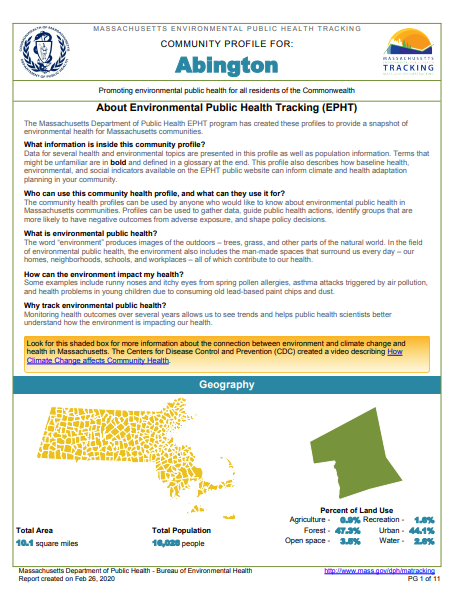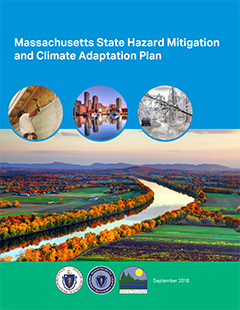Climate Change |
Climate change is expected to cause more heat waves, poor air quality days, inland and coastal flooding, sea-level rise, poor water quality, and extreme storms that negatively impact human health. This website provides tools and resources for public health agencies, the medical community, advocacy groups, municipalities, and residents to take action to minimize health impacts from climate change. Understanding extreme heat and rainfall projections can help municipal officials and communities plan adaptations to protect residents from extreme heat and flooding (See Graph).
How is climate change a public health concern?
Historically, climate change has been considered an environmental concern; however, there are a wide variety of ways that climate change can negatively impact human health. The most noticeable and publicized consequence of climate change is an increase in temperature leading to more intense heat events; however, climate change creates additional hazards such as air pollution events, sea-level rise, flooding, and severe weather that can result in both acute and chronic health impacts, including mental health. More information about the public health impacts of climate change is available here.
What climate hazards are expected in Massachusetts?
A climate hazard is any threat to human health that results from climate change. In Massachusetts, the most serious climate-related health hazards result from:
- Increasing numbers of very hot (>90°F) summer days
- Increasing precipitation leading to flooding
- Increasing storm-related inland and coastal flooding
- Rising sea levels
Climate change is expected to increase the number of days over 90°F each year, which may increase hospitalizations for heat-related illnesses. Climate change may also alter existing patterns of environmentally related diseases (e.g., asthma) and result in new health threats, such as tropical mosquito-borne illnesses.
How are people exposed to climate hazards?
Exposure to climate hazards depends on the type of climate hazard (flooding, heat, etc.), where a person lives or works, and their activities. For example, people who work outdoors, live in urban areas with limited greenspace, or lack air-conditioning are more likely to experience heat illness during extreme heat events. People who live near rivers or coastlines that experience flooding may come in contact with contaminated flood waters or experience respiratory impacts from mold growth in water-damaged homes or buildings. People anywhere in the Commonwealth may be exposed to extreme weather such as ice storms, hurricanes, or heavy rainfall.
Who is most vulnerable to climate change?
While climate change affects everyone, some groups of people are more likely than others to have health problems due to climate change. This means that exposure to a climate event (e.g., heat wave or severe storm) may make this group of people more likely to experience negative health effects. Some people who may be at risk are:
- Young children
- Older adults, especially those living alone
- People with health conditions such as heart disease, kidney disease, diabetes, or asthma
- People with physical disabilities including mobility challenges
- People using medical equipment that requires electrical power or medications that require refrigeration
- People with mental health challenges
- People who are living below the poverty line or with limited education or knowledge of English
- People of color
- People who work or exercise outdoors
- People living in areas at high risk of climate-related events such as flood zones, ocean surge zones and areas with little greenspace (e.g., “heat islands”)
Understanding vulnerability and identifying these populations within a community can improve climate change planning. During a heat wave, storm, or flood, more public health and emergency assistance will be needed in areas where there is a larger concentration of vulnerable persons or where there is a greater risk of exposure to climate hazards. The MDPH Climate Change Vulnerability Mapping Tool allows users to create custom maps that identify vulnerable populations and climate hazards, such as flood zones and storm surge zones.
How can Massachusetts prepare for climate change?
Actions taken to prepare for and minimize the effects of climate change are called climate adaptations. Adaptations reduce exposure and vulnerability to climate hazards in ways that protect both public health and built infrastructure. Climate adaptation strategies that protect public health include building flood-resistant emergency services complexes; raising awareness of ways to avoid contact and exposure to flood water; and improving the baseline health of a community so that residents are more resistant to climate change hazards.
How will climate change impact local health departments in Massachusetts?
Evidence indicates that the health effects of climate change will be felt most directly and severely at the local level. Local health departments will be key players in preparing for climate impacts and delivering health services to the public.
What is MDPH doing about climate change and health?
MDPH is promoting resilience to climate-related health impacts in communities throughout the Commonwealth through funding from a Cooperative Agreement from the Centers for Disease Control and Prevention (CDC). Climate and health preparation and prevention activities include:
- Promoting awareness of climate-related hazards and health risks in Massachusetts
- Providing technical assistance to communities seeking to protect residents from the health impacts of climate change
- Identifying and locating areas within municipalities where vulnerable residents live
- Identifying actions and strategies that promote strong, healthy and resilient communities
- Promoting understanding of climate change-related health impacts within state and local government agencies

MDPH uses the CDC Building Resilience Against Climate Effects (BRACE) Framework, a 5-step process for assessing health impacts of climate-change, identifying strategies, and evaluating activities that reduce climate-related health risks.
The MDPH Climate Enhanced Community Profile provides information and resources on climate change hazards, vulnerable populations, and environmental health for each of the 351 cities and towns in Massachusetts. This profile was produced by MDPH, supported by the CDC EPHT and CDC CRSCI (Climate Ready States and Cities Initiative) cooperative agreements.

What state-wide activities support climate adaptation?

The 2011 Massachusetts Climate Change Adaptation Report provides practical adaptation strategies for predicted changes in climate in Massachusetts, including support for improving existing public health, health care, local health infrastructure, and community resilience programs.
MDPH contributed public health and climate change expertise to the first State Hazard Mitigation and Climate Adaption Plan, which was required under Governor Baker’s Executive Order 569 “Establishing an Integrated Climate Change Strategy for the Commonwealth.” This statewide plan combined the 5-year update of the FEMA State Hazard Mitigation Plan with climate change projections and adaptation information. See https://resilientma.org for more information.
The Massachusetts Municipal Vulnerability Preparedness (MVP) program (created under Executive Order 569 and administered by the Executive Office of Energy and Environmental Affairs [EEA]), funds climate change assessment and adaptation planning workshops in cities and towns throughout the Commonwealth. Program information and community adaptation reports are available on the MVP website.
What are some examples of climate adaptations at the local level?
The MVP Action Grants administered by EEA provide support for communities to plan and design adaptations to climate change hazards, which also protect public health. A complete listing of funded projects and reports may be found on the program’s webpage.
The following examples show how communities used MVP grants to take actions to reduce the health impacts of climate change:
- Heat and Flooding: The City of Cambridge created a series of flyers and toolkits for residents and businesses on how to prepare for extreme heat and flooding from climate change.
- Extreme weather: The Town of Holden evaluated “green” electrical power backup systems to maintain the function of its municipal water systems during storm-related power outages.
- Sea level rise: The City of Newburyport assessed the vulnerability of their wastewater treatment facilities to increased flooding risks during storms and due to rising sea levels.
- Inland Flooding: The City of Northampton developed a plan to reduce climate change-related flooding risks using nature-based solutions.
For other examples of local adaptation initiatives, see the Municipal Vulnerability Preparedness Program Action Grants.
